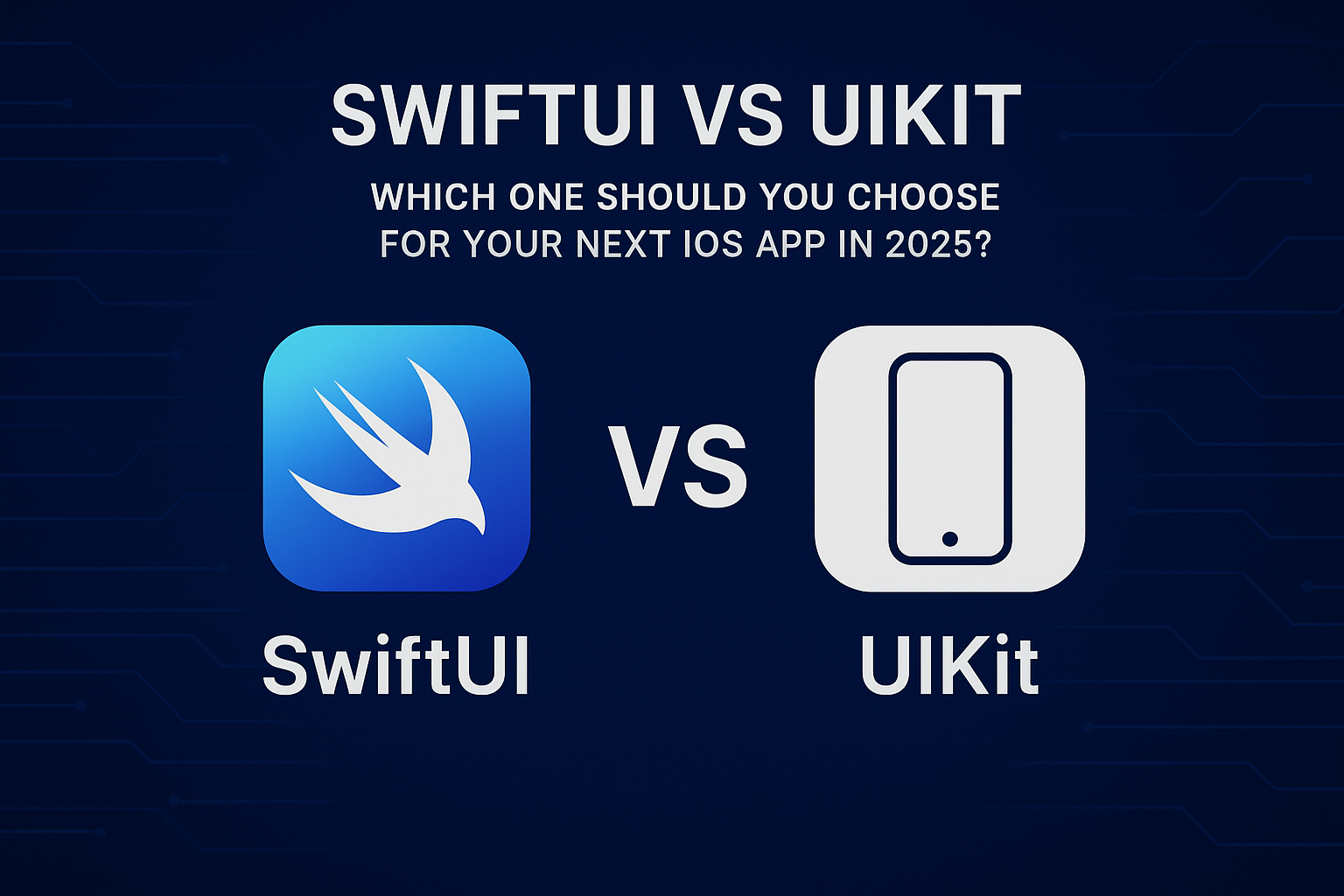Blog
Stay updated with the latest trends, tips, and tech insights from our expert team.

SwiftUI vs UIKit: Which One Should You Choose for Your Next iOS App in 2025?
IntroductionApple introduced SwiftUI in 2019 as a modern, declarative framework for building user interfaces across iOS, iPadOS, macOS, watchOS, and tvOS. Since then, it has rapidly matured — and in 2025, it’s becoming the default choice for many developers.But with UIKit still powering thousands of apps and offering unmatched flexibility, many businesses and developers face the same question:👉 Should we use SwiftUI or UIKit for our next iOS app?In this article, we’ll compare SwiftUI and UIKit, their strengths and weaknesses, and help you decide the right path for your project.What is UIKit?UIKit has been the backbone of iOS app development since the launch of the first iPhone. It uses an imperative programming model, meaning you write step-by-step instructions for how the UI should update.Pros of UIKit:Mature, stable, and battle-testedHuge library of third-party resources & community supportFine-grained control over UI elementsWorks with older iOS versionsCons of UIKit:More boilerplate code requiredHarder to maintain large projectsLess adaptable across multiple Apple platformsSlower development compared to SwiftUIWhat is SwiftUI?SwiftUI is Apple’s declarative UI framework. Instead of writing how the UI should update, you simply describe what the UI should look like at any given state, and SwiftUI handles the rest.Pros of SwiftUI:Faster development with less codeBuilt-in support for dark mode, accessibility, and localizationWorks seamlessly across iOS, iPadOS, macOS, tvOS, and watchOSEasy-to-read declarative syntaxPerfect for rapid prototyping and modern appsCons of SwiftUI:Still evolving, some APIs may be limitedRequires iOS 13+ (not suitable for very old devices)Advanced customizations may be easier in UIKitPerformance & Development SpeedUIKit: More control, but requires more lines of code and manual updatesSwiftUI: Faster to build, easier to test, and integrates with modern Apple technologies like Combine and async/awaitExample:Here’s how creating a simple button looks in UIKit vs SwiftUI: // UIKit let button = UIButton(type: .system) button.setTitle("Tap Me", for: .normal) button.addTarget(self, action: #selector(buttonTapped), for: .touchUpInside) // SwiftUI Button("Tap Me") { print("Button tapped") } With SwiftUI, you get the same functionality in fewer lines of code — cleaner and easier to maintain. When to Use UIKitMaintaining or updating older appsComplex, highly customized UIsWhen supporting devices below iOS 13When to Use SwiftUIBuilding new apps from scratchProjects requiring rapid development and scalabilityApps targeting the latest iOS, iPadOS, or macOS versionsCross-platform Apple ecosystem apps (iPhone, iPad, Mac, Watch, TV)Case Study: Why Businesses Should CareAt TechPilot IT Solution, we’ve helped businesses modernize their apps using SwiftUI. In one project, migrating an inventory management app to SwiftUI:Development time reduced by 30%UI consistency improved across iPhone and iPadEasier onboarding for new developersThis saved the client both time and costs, while delivering a sleek, future-proof app.ConclusionBoth UIKit and SwiftUI have their place in iOS development. UIKit remains a reliable choice for older apps and highly complex UI needs. But SwiftUI is the future of iOS development — offering faster development, cleaner code, and seamless cross-platform support.👉 If you’re starting a new project in 2025, SwiftUI is the smarter investment.Call to ActionAt TechPilot IT Solution, we specialize in building modern iOS apps using SwiftUI, UIKit, or a combination of both — tailored to your business needs.📩 Ready to build your next iOS app? Contact us today.

🧠 Integrating AI into iOS Apps: Using CoreML + Swift
Artificial Intelligence is rapidly transforming mobile app development—and iOS is no exception. Apple has made integrating machine learning models seamless with CoreML, allowing developers to bring intelligent features right into their apps using Swift.In this post, we’ll explore:What CoreML isHow to use it in your iOS appA quick walkthrough using a sample ML model 🔍 What is CoreML?CoreML is Apple’s machine learning framework, optimized for on-device performance and privacy. You can use it to:Classify imagesPredict user behaviorRecognize speech or textPerform natural language processingAnd more!It supports popular model types like .mlmodel, and can convert models from frameworks like TensorFlow, PyTorch, or scikit-learn. 🧰 How to Use CoreML in SwiftLet’s break it down into 3 main steps:1. Get an ML ModelYou can:Build your own model and convert it using coremltoolsDownload a pre-trained model from Apple’s Model GalleryUse Create ML to build your own custom modelExample: Let’s use MobileNetV2.mlmodel to classify images.2. Add the Model to Your ProjectDrag the .mlmodel file into your Xcode project.Xcode will auto-generate a Swift class for the model.Example:Swift let model = try! MobileNetV2(configuration: MLModelConfiguration()) 3. Use the Model in CodeHere’s a sample method to classify an image:Swift func classifyImage(_ image: UIImage) { guard let pixelBuffer = image.toCVPixelBuffer() else { return } do { let prediction = try model.prediction(image: pixelBuffer) print("Prediction: \(prediction.classLabel)") } catch { print("Failed to predict: \(error)") }} 🧠 Note: You’ll need an extension to convert UIImage to CVPixelBuffer—available on GitHub or Apple's docs. 🧪 Testing & DebuggingAlways test your model’s performance:On various devices (CoreML runs faster on newer chips)With edge cases (e.g., blurry or unusual images)Using real-world data instead of only training sets 🔐 Benefits of On-Device AIPrivacy: Data never leaves the deviceSpeed: No network latencyOffline Access: Works without an internet connection 📦 Final ThoughtsIntegrating AI in iOS apps using CoreML + Swift is not just possible—it’s powerful and beginner-friendly. With a few lines of code, you can turn your app into a smart, adaptive experience for users.Whether you're building a photo classifier, language translator, or custom recommender system—CoreML is your gateway to adding real-time intelligence to your iOS app.
